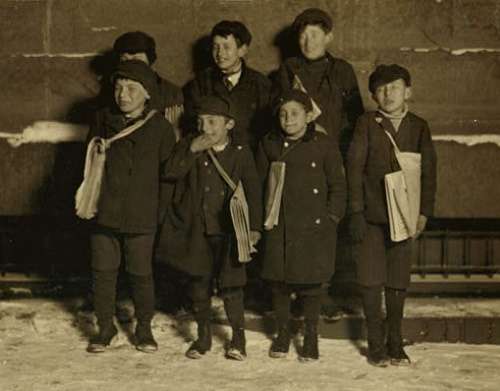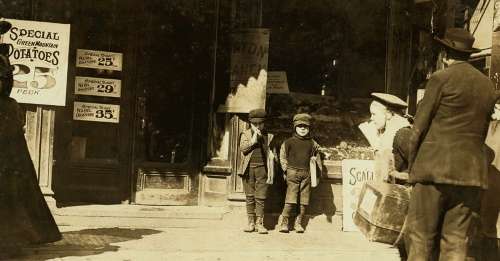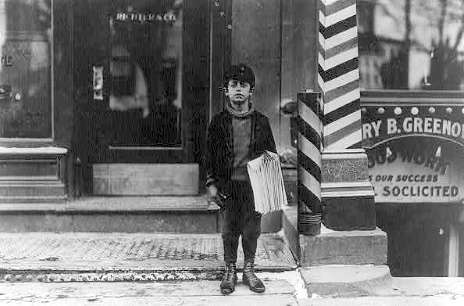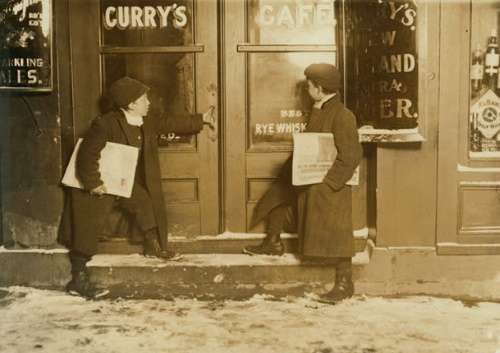The New York-based newsies strike, immortalized in the Disney film of the same name, succeeded in 1899. The Hartford newsies strike 10 years later did not — and all because of a former newsie.
Hartford Newsies

Hine’s caption: 9:00 P.M. March 4, 1909. Hartford, Conn. Group of newsies still selling although it was bitter cold and blizzardy. Smallest chap was 8 years old. The boys said he has been selling for 3 years. Boy next him (and) has been selling 4 years (called Bologna). Photo courtesy Library of Congress.
Early in 1909, social reformer Lewis Hine brought his Graflex camera to Hartford, Bridgeport and New Haven to record images of boys and girls on the streets. They worked as newsies, bootblacks and messenger boys.
Social reformers thought children shouldn’t work on the streets, where they learned about gambling, swearing and booze. They went into saloons to sell papers, knowing that drunks made good customers. The kids also worked long hours, sometimes starting out at 5 a.m., and returning home at midnight. They fought over territory, and people sometimes shortchanged the youngest newsboys who didn’t know how to make change.
Others, however, pointed out the children’s families, mostly poor immigrants, needed the pennies they earned to survive. Some young girls, for example, paid for school tuition with their earnings as newsies.
Herman Kopplemann
Herman Kopplemann had started out as a Hartford newsie in 1888 at the age of eight. He came to Hartford from Russia with his parents when he was two years old. He and his brother eventually formed a partnership to distribute Hearst and Pulitzer newspapers throughout Connecticut. They built it into the largest distributorship in the state.
At 24, Herman Kopplemann ran for city council and won, representing Hartford’s poor East Side. During his five terms in the council he brought improvements to the neighborhood: sewer upgrades, a public bath house and pay hikes for police officers and firefighters.
Toward the children who sold his newspapers, he showed less benevolence.
Hartford Newsies Strike

Hine’s caption: 7 year old twins. Been selling for 1 year. Sell sometimes until 8 P.M., Photo courtesy Library of Congress.
New York papers sold well in Connecticut, especially Joseph Pulitzer’s World and William Randolph Heart’s Evening Journal. The two millionaires battled each other for more circulation and bigger profit.
Typically, newspaper publishers bought back unsold newspapers from their distributors. But in 1909, they refused to do it anymore.
In Connecticut, that meant Herman Kopplemann would be the one to stick the newsies with the papers they couldn’t sell.
The newsies went on strike against Pulitzer and Hearst. According to the Shoeleather History Project, on May 1 newsies from all over the city assembled at a hall at the corner of Winthrop and Pleasant Streets. They formed a parade and marched in the rain behind a drum and bugle corps with a banner that urged people to buy only local newspapers. The next day they formed a union, the Hartford Newsboys’ Association, and elected officers.
At first it went well. Drugstores stopped stocking the Pulitzer and Hearst newspapers, people stopped buying them and supporters contributed to the strike fund. On May 17, the newsies marched through the streets again, wearing white hats and union pins and waving flags.
Scabs
Kopplemann, however, had no intention of backing down. He hired strikebreakers from out of town – at their peril, as it turned out, as the newsies beat them up. He spread rumors the strike had failed. And he enlisted his brother to form a rival ‘union.’
Hearst himself helped out. He sent an employee from New York to break the strike. A Hartford clothing store owner caught him buying a large quantity of boys clothing and shoes. Kopplemann had planned on offering the new clothes to the boys as a bribe to end the strike.
By the end of the third week, dissension spread among the strikers, probably instigated by the Kopplemanns and Hearst. Nineteen days after it began, the newsies voted to end the strike.
Some New Dealer
Herman Kopplemann then won election to the state Legislature. After lying, bullying and hiring scabs to break a children’s strike, he went on to get himself elected to Congress as a Democrat on a pro-labor ticket.
After serving five terms in Congress, he was defeated in 1946 and died 11 years later. Speaker of the House John McCormack memorialized him as a man who always extended a helping hand.
“There are many thousands of persons who are happier today because of Herman Kopplemann and his consideration of and his kindness to others,” McCormack said.
Tony Zazzaro
Among the Hartford newsies photographed by Lewis Hine were Paul and Tony Zazzaro. Hine’s caption read,
8 A.M. A cold and windy day. Small boy, Paul Zozzaro, 9 years old, begins at 7 A.M. daily. Then goes to school. Sells after school until 6 P.M. and later. Older brother, Tony, gets up at 5 every morning and sells before school. Then after school again.
Historian Joe Manning did some sleuthing about Tony and Paul Zazzaro. The boys’ parents had immigrated from Italy. Their father worked as a street sweeper, their mother took care of seven children. When Paul grew up he started a successful restaurant called The Capitol Grille.
Tony became one of Hartford’s political bosses. For many years he delivered the Italian vote and served for a term on the city council. He also owned parking garages and a brewery. He had two aides who became well-known Connecticut political figures: John Bailey and Abraham Ribicoff.
Robert Chiles, in his book, The Revolution of ’28: Al Smith, American Progressivism, and the Coming of the New Deal, wrote the triumvirate that ruled Hartford in 1928 consisted of Thomas J. Spellacy, Tony Zazzaro and Herman Kopplemann.
With thanks to Shoeleather History and Mornings on Maple Street.



